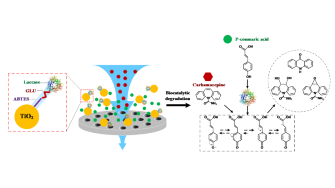Archived

The removal of the trace micropollutant in water has become an important ecological challenge. For example, bisphenol-A (BPA) is a commonly used additive in the plastic industries, and it has been detected in wastewater treatment facilities, underground water, rivers and lakes with concentration ranging from nanograms to micrograms per litre. BPA has been found to mimic estrogenic activity in human and animal body and therefore represent a general health threat. However, the removal of BPA is still a challenge as its complete removal cannot be achieved by conventional physico-chemical or biological water treatment process, and other oxidation process such as UV oxidation could potentially lead to higher toxic yields. Another representative micropolllutant is carbamazepine (5H-dibenzazepine-5-carboxamide, CBZ). It is a widely prescribed antiepileptic drug. Based on European classification and labelling of chemicals (92/32/EEC), CBZ is “R52/53 harmful to aquatic organisms and may cause long-term adverse effects in aquatic environment”. However, satisfactory removal of CBZ via the traditional physicochemical water treatment process is difficult to achieve due to the robust chemical stability and hydrophilicity of CBZ.
The use of enzymes such as laccase for the elimination of various micropollutant substances has shown great potentials. For example, the insoluble polymers formed after the BPA-laccase bio-degradation do not exhibited the estrogenic activity of the original BPA and can be easily removed from aqueous phase by filtration or sedimentation. In addition, laccase uses atmospheric oxygen as the final electron acceptor, which is an unlimited source in natural environment. However, the application of free laccase in wastewater treatment is constrained due to its poor stability and reusability. In this work, we developed a series of TiO2 nanoparticle based laccase immobilization techniques and incorporate the immobilized enzyme with membrane bioreactor for continuous micropollutant degradation. Satisfactory micropollutant removal was achieved. Furthermore, in order to explore the feasibility of using the biocatalytic membrane reactor with wastewater condition, the biocatalytic system performance was investigated under industrial relevant conditions, including a wide pH range, the presence of various ions and humic substances.
Membrane Material Development
+61 2 9385 6092
- Research team
- Funding body
- Publications
Vicki Chen
Jingwei Hou
Chao Ji (PhD student)
- Australian Research Council Discovery Project (DP1095930)
- CRC for Polymers
- Hou, J., Dong, G., Ye, Y. and Chen, V., 2014. Laccase immobilization on titania nanoparticles and titania-functionalized membranes. Journal of Membrane Science, 452, pp.229-240.
- Hou, J., Dong, G., Ye, Y. and Chen, V., 2014. Enzymatic degradation of bisphenol-A with immobilized laccase on TiO2 sol–gel coated PVDF membrane. Journal of Membrane Science, 469, pp.19-30.
- Hou, J., Dong, G., Luu, B., Sengpiel, R.G., Ye, Y., Wessling, M. and Chen, V., 2014. Hybrid membrane with TiO2 based bio-catalytic nanoparticle suspension system for the degradation of bisphenol-A. Bioresource technology, 169, pp.475-483.
- Ji, C., Hou, J., Wang, K., Zhang, Y. and Chen, V., 2016. Biocatalytic degradation of carbamazepine with immobilized laccase-mediator membrane hybrid reactor. Journal of Membrane Science, 502, pp.11-20.
